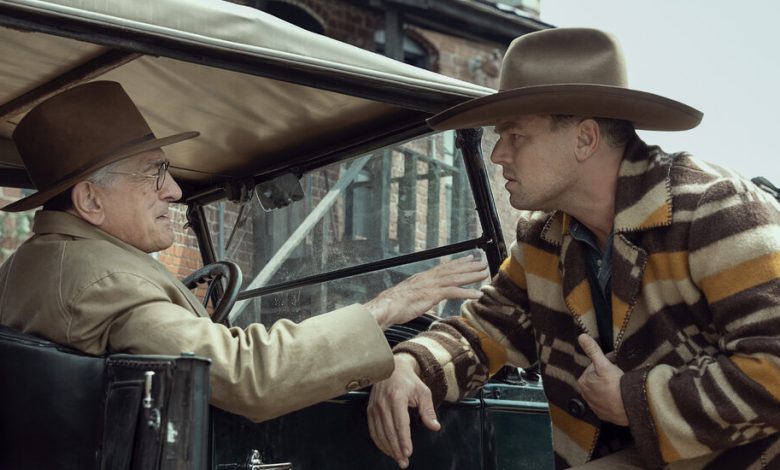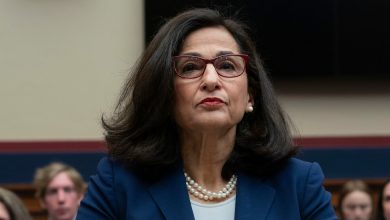‘Killers of the Flower Moon’ Review: An Unsettling Masterpiece

There’s a scene in Martin Scorsese’s “Killers of the Flower Moon” when the screen fills with men toiling in what looks like a lake of fire. Inky silhouettes in a red-orange void, they look like Boschian imps, but these are ordinary men in a hell of human making. It’s a rightly apocalyptic image for this cruel and baroque American story of love, murder, greed and unspeakable betrayal in 1920s Indian Country, a true-crime epic that Scorsese — with grace, sorrow and sublime filmmaking clarity — has turned into a requiem for the country.
This may seem like strange territory for Scorsese, with his New York wiseguys and street corners. Yet he has always ranged wide and far in his work, from the Roman Empire in “The Last Temptation of Christ” to 1930s Tibet in “Kundun” and then home again for the 1980s and ’90s of “The Wolf of Wall Street.” During his wanderings, Scorsese has never strayed far from Hollywood or rather its filmmaking foundations, which he has helped keep alive through his tireless advocacy for the art, though principally by doing what all great artists do: by reinvigorating and reinventing forms, and making them his own.
Throughout, Scorsese has also reminded you that there many ways to tell stories, including about evil. This one, set largely on the Osage Reservation in northern Oklahoma, revisits a history of violence as fraught and bloody as that of the United States itself. The crimes it primarily recounts trace back to 1921 (there were earlier killings), and involved the murder of several dozen Osage (there may have been many more victims). Some were shot, others were blown up, while still others died from an enigmatic wasting illness, though were likely poisoned. The era is often referred to as the Osage Reign of Terror, an odd description that wrongly implies the Osage were somehow responsible for the horrors perpetuated on them.
Scorsese, who shares screenplay credit with Eric Roth, has given this story both scale and intimacy. This is a big, bigger-than-life movie with sweeping vistas and soaring camerawork, but one that incessantly shifts from bright, wide-open spaces to interiors as shadowy as their inhabitants. First among the richly populated cast is Ernest Burkhart (Leonardo DiCaprio), a war veteran who, when he steps off a steam locomotive and onto a crowded train platform in Fairfax, Okla., plunges into a Hobbesian churn of humanity. All around him, people are moving, shouting; some are fighting. It’s exciting and disorienting, and Ernest looks at once energized and more than a little bewildered, like a child set adrift in a crowd of strangers.
Always a quick worker, Scorsese establishes the time and place with seamless efficiency. Ernest has come to Oklahoma to work with his uncle, William Hale (a terrific Robert De Niro), a well-to-do, glad-handing cattle rancher who lives with his small family in a large, gloomy house surrounded by prairie. Known as “the King of the Osage Hills,” Hale welcomes Ernest into the fold with amused prurience: He asks if Ernest brought back anything back from the war, a.k.a. the clap (no), and if he likes women (yes). Hale also delivers a brief lesson on the Osage, who in recent decades have become enormously wealthy from their oil strikes. They are, Hale says, “the finest, the wealthiest and most beautiful people on God’s earth.”
Ernest tethers you to the story and its early buzz and confusion, and you discover this new world and its people largely through him. He soon sets himself up as a chauffeur-for-hire in Fairfax, a boomtown that’s still shaking off the dust of the 19th century. There, Scorsese makes an entire social order come alive — he has an ethnographer’s eye — as roadsters race past horses and buggies on the main dirt strip, and a white salesman on bended knee implores a Native family to buy another luxury automobile. It’s amid this tumult that Ernest meets Mollie Kyle (Lily Gladstone, wonderful), an Osage woman with watchful eyes and a colorful blanket that she drapes over her shoulders like a royal mantle. They flirt, and soon wed.
Ernest and Mollie’s courtship develops with graceful naturalism — the two actors make immediate sense together — and their relationship grounds the story emotionally. Now 48, DiCaprio is about twice as old as the real Ernest was at the time, and age has made his face more yielding and eloquent. Ernest looks like he’s been beaten up by life (the war presumably took a toll, too), and when you first see him, a large frown is tugging his face downward, giving him a sour, dyspeptic look that only really lifts when his and Mollie’s romance takes flight. Sometime later, you realize that his uncle has the exact same frown, although Hale, who presents himself as a welcoming man of the people, is careful about who sees his displeasure.
The movie is based on David Grann’s 2017 book “Killers of the Flowers Moon: The Osage Murders and the Birth of the F.B.I.,” a nonfiction account of how, in the early 20th century, greedy whites preyed on the newly oil-rich tribe. The book is informative, stark and relentlessly grim; the depravity of some of the crimes can be shocking. In adapting it, Scorsese and Roth have more or less jettisoned the second half of Grann’s subtitle: There’s little in the movie about the Federal Bureau of Investigation, its foundational years or its newly appointed young director, J. Edgar Hoover. (The story may horrify you, but it’s hard not to laugh when DiCaprio meets his first fed — portrayed by the reliably good Jesse Plemons — given that DiCaprio played Hoover in “J. Edgar.”)
Scorsese and Roth have also thinned the larger history that Grann sketches in, leaving just enough of the Osage’s catastrophic relations with the United States to connect the present to the past, and to give some backdrop to the guardianship system the government instituted to control both tribal members and the wealth from their mineral rights. (Full-blooded American Indians, Grann writes, were usually declared “incompetent” and appointed white guardians.) That history emerges elliptically throughout the movie in different narrative forms, including in Hale’s descriptions of the Osage, via an illustrated book, during a tribal meeting and on a radio program — each a reminder that history belongs to those who tell it.
For his telling, Scorsese has drawn on assorted genres — the movie is at once a romance, a western, a domestic drama, a whodunit and, finally, a police procedural — that effortlessly mix, ebb and flow. It’s an energetic and unexpected amalgam, but partly because Scorsese uses genre to his ends rather than conforming to its conventions, the overall effect can be destabilizing: He’s not boxed in by obvious narrative cues, and neither are you. That means that you’re never sure where the story is headed or why, which is enjoyable and adds to the overall mystery. Yet, as the murders continue to mount, and the story grows ever more outrageous and horrifying, this destabilization can also feel ominous, even dangerous.
Part of the pleasure and, for lack of a better word, magic of Scorsese’s work is how both the entirety of his filmmaking and his subjects are of an expressive piece when he’s in his groove. Scorsese once said of a John Cassavetes film, “the emotion was in the emulsion”: Like recognizes like. That’s what Scorsese imitators badly miss when they try to crib from him. When Henry Hill and his girlfriend stroll into the Copacabana during the famous long take in “Goodfellas” — a blissed-out interlude in which the characters, camera and music flow together — Scorsese isn’t showboating; he is, rather, using the full force of his technique to capture a specific moment in time in all its delirium and voluptuousness.
After Ernest and Mollie marry, he moves into her house, where she lives with her ailing mother, Lizzie Q (Tantoo Cardinal), and her sister Anna (a vibrant Cara Jade Myers), a sybarite with a pistol in her handbag. The story’s romance is warmly inviting, and DiCaprio and Gladstone work beautifully together, their different performance styles — Ernest is physically demonstrative while Mollie is reserved — creating a contrapuntal whole. You believe in these characters but also, crucially, you believe them as a couple and in the tenderness of their love. You watch them settle into each other’s bodies in bed and, at other times, lean into each other so that their foreheads touch, as if to silently share their thoughts.
Here, there’s emotion in every camera move, darting look, mirroring frown, silence, gesture as well as in the crowds that by turns embrace and threaten; it’s also in the pointed repeat of a possessive adjective. When Ernest is first being taken to Hale’s house, he asks the Osage driver, Henry Roan (William Belleau), whose land this is. Henry’s answer (“my land”) echoes what Mollie says when Ernest asks her what color her skin is (“my color”), each an assertion of sovereignty that becomes more meaningful as one after another Osage is murdered. It’s not for nothing that much later when Hale dresses down Ernest, Scorsese shoots them on a black-and-white checkered floor, underscoring their respective roles as king and pawn.
After I saw “Killers of the Flower Moon” a second time, I kept flashing on “Goodfellas” and “Kundun” because the intimacy and horror of this new movie’s violence reminded me of those earlier films. The violence here has a specific history but also a different texture and depth: It seeps into this movie like the crude oil that both liberates and condemns the Osage. You see the oil bubbling up in the prairie early on, like some misplaced witchy cauldron. As the oil begins to gurgle and then to gush, it splatters a half-dozen Osage men who’ve started to dance ecstatically at the discovery, their bodies slicked with petroleum — a harbinger of the blood that, as Scorsese reminds you in this heartbreaking masterpiece, has long engulfed us all.
Killers of the Flower Moon
Rated R for gun and bomb violence, and an open-air postmortem. Running time: 3 hours 26 minutes. In theaters.



